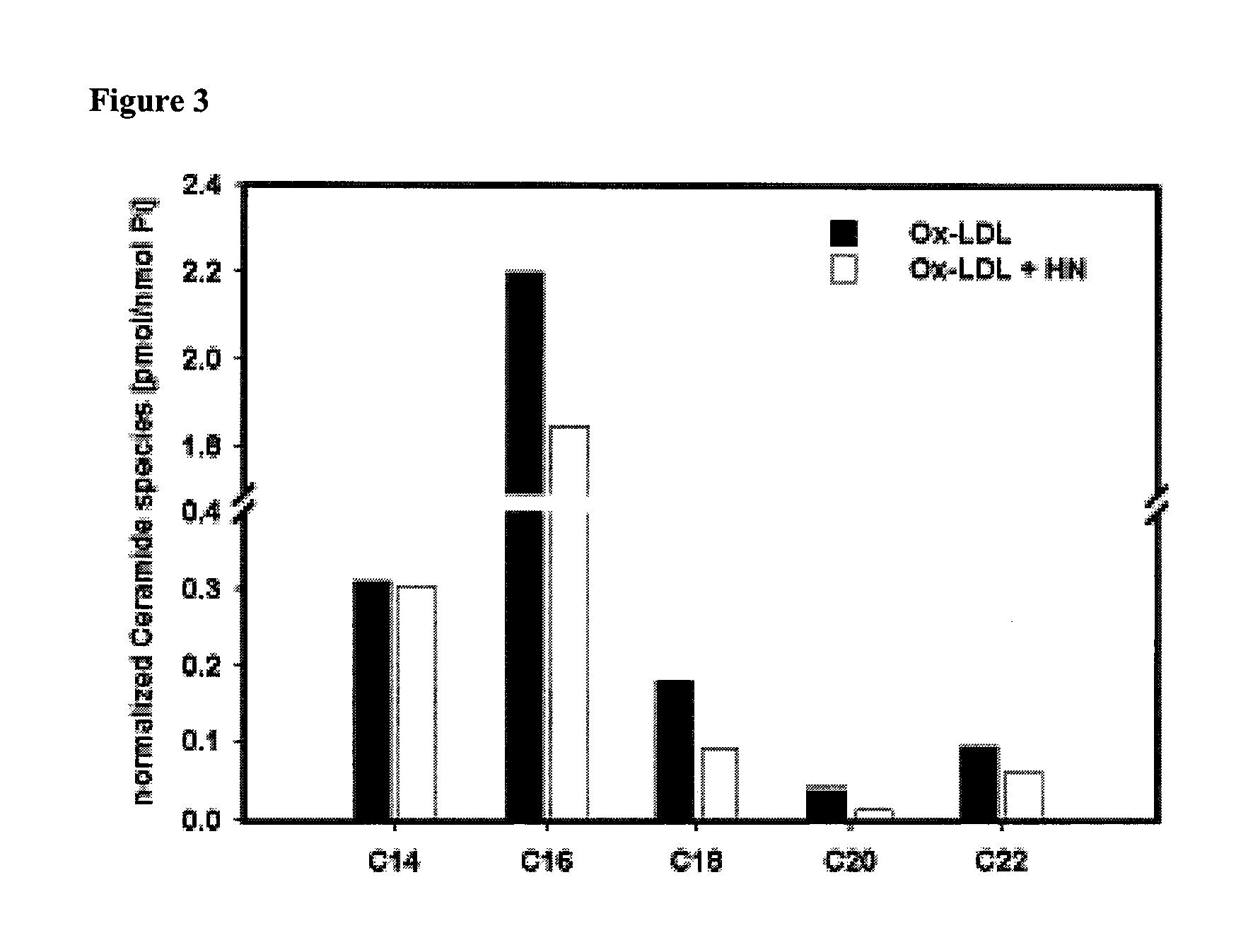Humanin and humanin-analogues for the management of atherosclerosis
a technology of humanin and atherosclerosis, which is applied in the field of humanin and humaninanalogues for the management of atherosclerosis, can solve the problems of cardiac disease being the leading cause of morbidity and mortality, and achieve the effect of improving the survival rate of endothelial cells and easing symptoms and diseas
- Summary
- Abstract
- Description
- Claims
- Application Information
AI Technical Summary
Benefits of technology
Problems solved by technology
Method used
Image
Examples
example 1
Humanin Attenuates Oxidized LDL Induced Reactive Oxygen Species Production in Human Aortic Endothelial Cells
[0118]Prior studies have reported that treatment of vascular endothelial cells with oxidized low density lipoprotein (LDL) stimulates reactive oxygen species (ROS) formation. To test whether humanin (HN) affects Ox-LDL induced ROS production in endothelial cells, the fluorescent probe dihydroethidium was utilized in order to detect superoxide in living cells. DHE fluorescence was measured in human aortic endothelial cells (HAECs) preincubated with HN and subsequently exposed to Ox-LDL. Intracellular ROS production was monitored by following the conversion of the oxidant sensitive dye dihydroethidine to fluorescent ethidium.
[0119]To accomplish this, as described in Bachar et al. (2010) Cardiovasc. Res. 88(2):360-6 (incorporated by reference in its entirety). HAECs were maintained in M200 medium containing low serum growth supplement and 1% penicillin-streptomycin (Invitrogen). ...
example 2
Humanin Attenuates Ox-LDL Apoptosis in HAEC
[0121]During atherosclerosis the ongoing formation of ROS results in the induction of apoptosis in the vascular wall. Whether HN could prevent HAECs from undergoing apoptosis after Ox-LDL exposure was investigated.
[0122]To accomplish this, a TUNEL assay was applied to measure the levels of apoptosis in HAECs treated with or without HN prior to exposure with Ox-LDL (FIG. 2). HAECs were plated on glass cover slips and incubated overnight with or without added HN (0.1 μM). The cells were then exposed to Ox-LDL (100 μg / ml; Biomedical Technologies Inc.) for 6 hours at 37° C. in the absence of HN. Apoptotic cells were quantified by TUNEL assay using the In Situ Death Detection Kit® (Roche Applied Science), mounted in SlowFade containing DAPI (Invitrogen) and observed by flourescent microscope. Apoptotic cells were defined based in morphological changes in the nuclei and the fluorescent intensity after TUNEL staining. The apoptotic index (AI)=(num...
example 3
Humanin Decreases Cellular Ceramide Levels
[0124]Ox-LDL is thought to increase the levels of cellular ceramide. C-16-ceramide is known to be involved in apoptosis. Therefore, whether HN would influence ceramide levels during Ox-LDL triggered oxidative stress was tested.
[0125]HAECs were plated on glass cover slips and incubated overnight with or without added HN (0.1 μM). The cells were then exposed to Ox-LDL (100 μg / ml; Biomedical Technologies Inc.) for 6 hours. Cells were then scraped into PBS, pelleted and frozen in liquid nitrogen. These samples were sent to MUSC-lipidomics core (Lipidomics Analytical Unit) for processing to detect and quantify individual ceramide species by HPLC / MS / MS. Pretreatment with HN resulted in a decrease in total cellular amount of ceramides, including C16-ceramide (FIG. 3).
PUM
| Property | Measurement | Unit |
|---|---|---|
| Concentration | aaaaa | aaaaa |
| Size | aaaaa | aaaaa |
Abstract
Description
Claims
Application Information
 Login to View More
Login to View More - R&D
- Intellectual Property
- Life Sciences
- Materials
- Tech Scout
- Unparalleled Data Quality
- Higher Quality Content
- 60% Fewer Hallucinations
Browse by: Latest US Patents, China's latest patents, Technical Efficacy Thesaurus, Application Domain, Technology Topic, Popular Technical Reports.
© 2025 PatSnap. All rights reserved.Legal|Privacy policy|Modern Slavery Act Transparency Statement|Sitemap|About US| Contact US: help@patsnap.com



